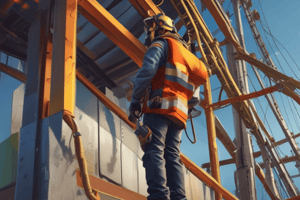Podcast
Questions and Answers
Which of the following is NOT a component of a Personal Fall Arrest System (PFAS)?
Which of the following is NOT a component of a Personal Fall Arrest System (PFAS)?
What is the primary purpose of guardrails in elevated work areas?
What is the primary purpose of guardrails in elevated work areas?
Which safety procedure should be implemented to enhance communication and safety among workers at heights?
Which safety procedure should be implemented to enhance communication and safety among workers at heights?
What should be done to ensure ladders used for working at heights are safe?
What should be done to ensure ladders used for working at heights are safe?
Signup and view all the answers
Which of the following is essential for an effective emergency response plan for working at heights?
Which of the following is essential for an effective emergency response plan for working at heights?
Signup and view all the answers
Study Notes
Working at Heights
Safety Protocols
-
Risk Assessment
- Identify hazards associated with working at heights.
- Evaluate the level of risk and determine control measures.
-
Training
- Ensure all workers are trained in fall protection and safety procedures.
- Regularly refresh training and provide updates on new regulations or equipment.
-
Work Procedures
- Develop and follow safe work practices tailored to specific tasks at height.
- Implement a buddy system for added safety and communication.
-
Supervision
- Assign competent supervisors to monitor work at heights.
- Ensure that supervision includes adherence to safety protocols.
-
Emergency Preparedness
- Create an emergency response plan specific to working at heights.
- Practice rescue scenarios and ensure workers are familiar with procedures.
Fall Protection Equipment
-
Personal Fall Arrest Systems (PFAS)
- Comprises a full-body harness, lanyard, and anchor point.
- Must be inspected before each use for wear and damage.
-
Guardrails
- Install guardrails around elevated work areas.
- Must meet specific height and strength requirements.
-
Safety Nets
- Used to catch falling workers or materials.
- Must be installed below the work area, adequately secured, and inspected regularly.
-
Ladders and Scaffolding
- Ensure ladders are stable and inspected for defects.
- Scaffolding must be erected by trained personnel and inspected before use.
-
Harnesses and Connectors
- Harnesses should fit properly and be adjusted for comfort.
- Ensure connectors are compatible and meet safety standards.
-
Rescue Equipment
- Have equipment readily available for emergency rescues.
- Train workers on the proper use of rescue equipment.
Safety Protocols
- Conduct thorough risk assessments to identify potential hazards when working at heights.
- Evaluate risks and establish appropriate control measures to mitigate them.
- Provide training focused on fall protection and safety protocols, ensuring regular updates to keep personnel informed on new regulations and equipment.
- Implement safe work practices tailored for specific tasks at height, and use a buddy system to enhance safety and communication among workers.
- Assign competent supervisors to oversee work at heights, ensuring they enforce adherence to safety protocols.
- Develop an emergency response plan specifically for working at heights, and conduct regular practice drills to familiarize workers with rescue procedures.
Fall Protection Equipment
- Utilize Personal Fall Arrest Systems (PFAS), which include a full-body harness, lanyard, and secure anchor point; these systems must be inspected for wear before each use.
- Install guardrails around elevated work areas, ensuring compliance with designated height and strength standards.
- Employ safety nets positioned below work areas to catch falling workers or materials; these nets need to be secured and regularly inspected for effectiveness.
- Check that ladders are stable and free of defects before use; scaffolding needs to be assembled by trained personnel and inspected thoroughly.
- Ensure that harnesses are fitted correctly to the individual and adjusted for comfort; connectors must be compatible and adhere to safety specifications.
- Ensure that rescue equipment is readily available and that all workers are trained in its proper usage in case of an emergency.
Studying That Suits You
Use AI to generate personalized quizzes and flashcards to suit your learning preferences.
Description
This quiz covers essential safety protocols for working at heights, focusing on risk assessment, training, work procedures, and emergency preparedness. Participants will learn about the importance of proper supervision and the use of personal fall arrest systems. Test your knowledge on maintaining safety standards in height-related tasks.




